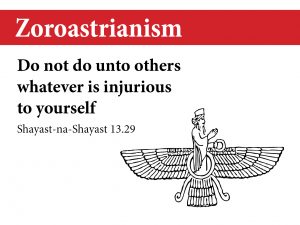INTRODUCTION
In most faith traditions, it is common for the adherents to use the sacred writings of their tradition for purposes of meditation and reflection as well as for community or congregational prayer.
As the international interfaith movement grows, it is becoming more common to use sacred texts from several religious traditions in both individual and communal prayer. Multi-faith prayer services are one context that frequently features sacred writings from many religions.
A Rule Made of Gold
This document contains a number of meditation and reflection exercises using various sacred texts. These sacred writings are actually 13 expressions of the Golden Rule as found in a number of faith traditions. To view or download these 13 sacred texts, click here.
This listing of texts was originally compiled for inclusion in the Scarboro Missions Golden Rule Poster. Using scripture and symbol, this poster features the Golden Rule in 13 religions. The poster has visual and symbolic power that is useful for both individual and group reflection.
The Golden Rule Poster is used as a tool for reflection in all the exercises in Section #3 of this document. All other meditation exercises do not require the use of the poster.
To view or order the Golden Rule Poster, click here.
The simplicity, power and universality of the Golden Rule make it an excellent subject for meditation and reflection. Known also as the Ethic of Reciprocity, the Golden Rule emphasizes values of mutuality, reciprocity and interdependence. Many regard it as the most concise and general principle of ethics.
The Golden Rule is arguably the most consistent and most prevalent ethical teaching in history. It is found in numerous cultures, religions, ethical systems, secular philosophies, indigenous (Native) traditions, and even in the mathematical sciences (e.g. the golden mean). And because the Golden Rule crosses so many traditions and philosophies, it possesses tremendous moral authority and reveals a profound unity underlying the diversity of human experience.
Given its omnipresence across history, the Golden Rule could be described as a universal ethic. In these Golden Rule meditation exercises, participants will thus be reflecting from the perspective of a universal wisdom.
For more information about the Golden Rule, see the Golden Rule Across the World’s Religions section of the Scarboro Missions website.
A contemplative approach to the Golden Rule
In a noisy, frenetic and fast-paced society, there is little time for quiet, solitude or reflection. As a result, our lives are often lived superficially and we lack adequate occasions for in-depth reflection. For these reasons, the methodology of this document encourages a meditative and contemplative approach to the Golden Rule.
Adaptable to various audiences
Among the world’s religions there exists a broad range of approaches to ethics, meditation and spirituality. Accordingly, the authors of this document invite various faith groups to adapt or change these meditation exercises as they deem appropriate. Members of faith traditions other than those represented by the 13 expressions of the Golden Rule in this document should feel free to include an expression of the Golden Rule from their tradition as part of their reflection and meditation. These meditation exercises can be used with single-faith and multi-faith audiences as well as with those who do not identify themselves with any particular faith tradition. A survey of history indicates that there are numerous secular expressions of the Golden Rule; one or more of these can be used in this meditation experience.
Reflection with young people
The exercises presented in this document have been developed for use with adults. But some of these can be adapted for teen and pre-teen audiences. Meditation #2.3 and all the meditations in Section 3 are particularly adaptable for youth.
Multilingual expressions of the Golden Rule
On the Scarboro Missions website, the 13 expressions of the Golden Rule are available in English, French, German, Italian and Spanish. To view or download these various translations, click here. At this time, the meditation exercises are available only in English. But any individual who is fluent in English and one of these languages will be able to use these exercises to facilitate a group reflection with the respective language group.
Some of these meditation exercises use the Scarboro Missions Golden Rule Poster as a visual aid for reflection purposes. At this time, the poster is printed only in English; but other language groups can use this poster because any meditation can be greatly enhanced by the poster’s physical, visual and symbolic properties.
Individual and group reflection
All of these meditation methods, with the exception of Meditation # 2.13, are designed for individual use. But each meditation method contains instructions for a facilitator who wishes to adapt it for a group experience. See Appendix 3: Application to a Group Experience.
Time duration of meditation and reflection periods
Individuals are encouraged to determine their own time schedule for these meditations. Experience has demonstrated that a range of 15 to 30 minutes works well for most people. But some individuals prefer a longer period. Facilitators of the group reflections are encouraged to design their own schedules and timelines.
Journaling
Journaling is encouraged in these meditations. Some individuals may prefer to record their reflections during the meditation exercise and some afterward. Individuals who are not comfortable recording their thoughts, learnings and insights on paper are encouraged to employ alternative media such as art, collage and tape-recording.
Do-it-yourself Golden Rule workshop outline
In addition to these meditation exercises, Scarboro Missions has produced Guidelines for a Golden Rule Workshop that enables individuals or organizations to create and facilitate group discussions on the Golden Rule. The workshop is outlined in 13 detailed steps and provides the facilitator with lots of options and themes.
We want your feedback
We invite feedback from those who use these meditations. We are particularly interested in any changes or improvements to this document that you might suggest. Contact Paul McKenna at interfaithgold@gmail.com

